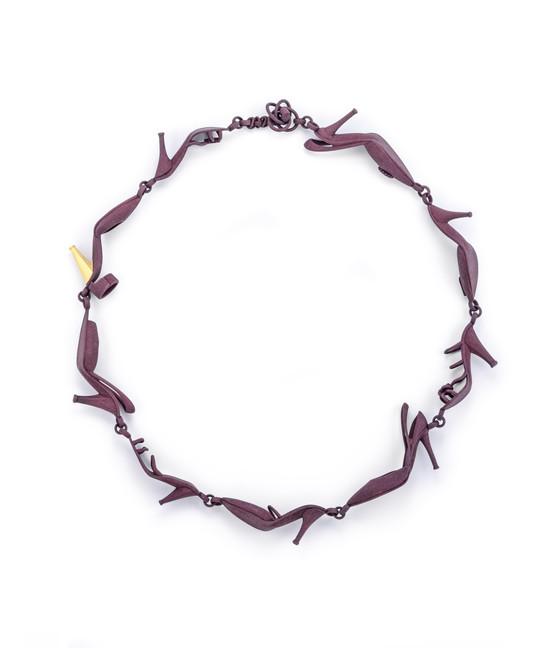3D printing once was in the realm of the manufacturing industry where rapid prototyping (also known as additive manufacturing) was commonly used by product engineers to make mock-ups or parts. They would create a computer-aided design (CAD) file and send it off to the 3D printer, which would convert the virtual 3D model to a physical object by successively stacking thin layers of material on top of each other. The completed object could be made of many types of materials ranging from plastic to glass to metal. In the past few years, 3D printing broke out of the manufacturing field and is now used by artists to make all sorts of interesting works of art ranging from sculptures to garments to jewelry. The Fashionista Golden Girl necklace by Dutch artist Ted Noten (M.2013.221.24) is one object on display in Beyond Bling: Jewelry from the Lois Boardman Collection that has been 3D printed.
With the naked eye, it did not appear that the necklace was 3D printed. 3D-printed objects straight out of the printer have characteristic steps in sloped or curvy areas, akin to pixelation in a 2D digital photograph. It was only when we put the necklace under the microscope were we able to find concentric ellipses in areas of high curvature—telltale signs that the object was made layer by layer using a 3D printing process. These circular ridges (they almost look like fingerprints!) are the remains of the steps that were polished down during the post-processing stage.
At really high magnification, we were even able to see purple plastic grains as well as shiny clear beads mixed together. Scientific techniques (Fourier Transform Infrared and X-Ray Fluorescence spectroscopy) were employed to identify the materials used in printing this object. It turned out that the plastic was nylon, which was reinforced with tiny glass beads.
The grainy surface also indicated that the necklace was made using the selective laser sintering (SLS) 3D printing process. During this process, a laser is scanned back and forth across a thin layer of the nylon/glass powder mixture. In the areas where the powder is exposed to the laser, the heat from the laser fuses or clumps together the powder particles. The platform on which the powder lies is then lowered and the next layer is ready to be zapped by the laser. Layer by layer, this process is repeated until the object is complete.
A similar 3D printing technique was used to make Islet ǀ Stainless bracelet by Doug Bucci (M.2014.198.35), which is part of the Boardman collection.
When we investigated the metal composition of the bracelet using X-Ray Fluorescence spectroscopy, we found that the bracelet was actually made of stainless steel (an alloy composed of iron with some chromium) and bronze (a copper and tin alloy). This was curious, because these metals are not normally mixed together . . . unless it had been 3D printed! Sure enough, under low magnification, we found the characteristic stepped pattern, but only on the inside of the bracelet, the areas where these ridges could not be so easily polished away.
The bracelet was probably also made using the SLS technique. However, lasers cannot easily melt metal, so the steel powder in the powder bed of the 3D printer is actually coated with a plastic. As the laser zaps across the powder surface, it melts the plastic, fusing the coated metal powder particles together. At this stage the bracelet is very fragile because it is only being held together by the bits of plastic. The bracelet is also full of air pockets (the spaces between the coated metal particles). To strengthen the bracelet, the “par-baked” bracelet is gently placed in a very hot oven. In the oven, the high temperature burns off the plastic. This is also when melted bronze is liquid enough to wick through the porous steel structure, filling up all the voids. This explained why, under high magnification, the surface looks mostly gray with yellow islands.
The two 3D-printed works of art described in this blog are just a few of the interesting jewelry pieces we studied while working on the Lois Boardman Jewelry project. Sometimes artworks are not what they seem. They are also perfect examples of what happens when art, science, and technology come together!
See Ted Noten's Fashionista Golden Girl necklace on display in Beyond Bling: Jewelry from the Lois Boardman Collection, through Sunday, February 5, 2017.





